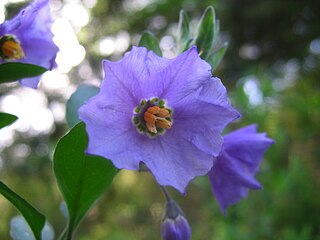
Solanum xanti, known commonly as chaparral nightshade, purple nightshade, and San Diego nightshade, is a member of the genus Solanum. It is native to the Western United States in Arizona, California, Nevada, and Oregon, and to northwest Mexico in Baja California.
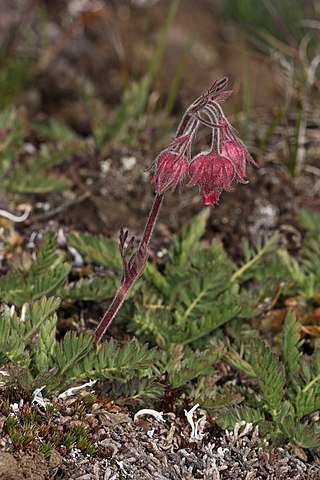
Geum triflorum, commonly known as prairie smoke, old man's whiskers, torchflower, three-sisters, long-plumed purple avens, lion's beard, or three-flowered avens, is a spring-blooming perennial herbaceous plant of the Rosaceae family. It is a hemiboreal continental climate species that is widespread in colder and drier environments of western North America, although it does occur in isolated populations as far east as New York and Ontario. It is particularly known for the long feathery plumes on the seed heads that have inspired many of the regional common names and aid in wind dispersal of its seeds.

Chorizanthe pungens is a species of flowering plant in the buckwheat family known by the common name Monterey spineflower. It is endemic to California, where it is known from the San Francisco Bay Area south along the Central Coast.

Tetramolopium is a genus of plants in the tribe Astereae within the family Asteraceae.

Potentilla diversifolia or Potentilla × diversifolia is a species of flowering plant in the Rose Family (Rosaceae) known by the common names varileaf cinquefoil, different-leaved cinquefoil, and mountain meadow cinquefoil.
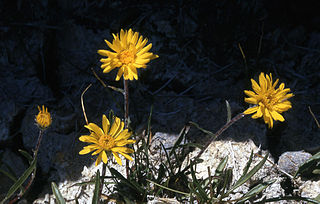
Pyrrocoma uniflora is a species of flowering plant in the family Asteraceae known by the common name plantain goldenweed. It is native to western North America from central Canada to California to Colorado, where it grows in several types of habitat, including forest and meadows with alkali soils, such as those near hot springs. It is a perennial herb growing up to 40 centimeters tall, the stems reddish and usually with a thin to thick coating of woolly fibers. The lance-shaped, toothed leaves are usually woolly, the largest near the base of the plant reaching up to 12 centimeters in length. The inflorescence is a single flower head or a cluster of a few heads, each lined with woolly phyllaries. The head contains yellow disc and ray florets. The fruit is an achene which may be over a centimeter long including its long pappus.
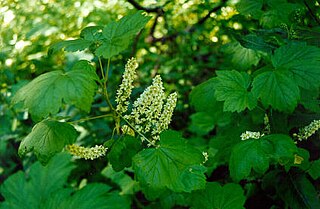
Ribes hudsonianum is a North American species of currant, known by the common name northern black currant.
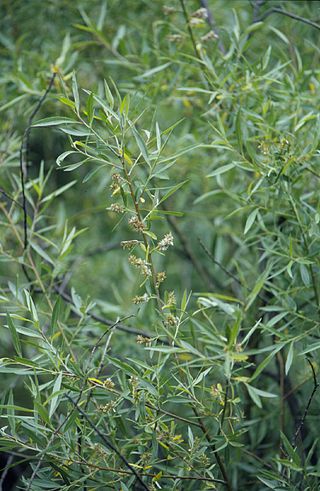
Salix geyeriana is a species of willow known by the common names Geyer's willow, Geyer willow and silver willow. The type specimen was collected by the botanist Karl Andreas Geyer, for whom it was named. Its conspicuous, yellow flowers begin to bloom as early as March, to as late as the end of June.
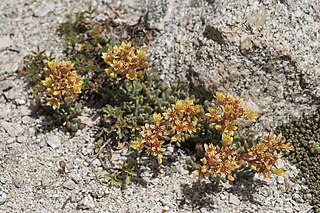
Sedum obtusatum is a species of flowering plant in the family Crassulaceae known by the common name Sierra stonecrop. It is native to the Sierra Nevada and adjacent high mountain ranges of California, its distribution extending north into Oregon and east into Nevada. It grows in rocky mountain habitat.

Townsendia condensata is a species of flowering plant in the family Asteraceae known by the common names cushion Townsend daisy and cushion townsendia. It is native to North America where it is known from many scattered occurrences in the mountains of the western United States and Alberta in Canada. It is mainly limited to the alpine climates of high mountain peaks, where it grows in meadows, tundra, and barren, rocky talus. It grows alongside other alpine plants such as Eriogonum androsaceum.

Astragalus cremnophylax is a rare species of milkvetch known by the common names sentry milkvetch and cliff milkvetch. It is endemic to Arizona, where the three varieties grow in three separate locations. The rarest variety, var. cremnophylax, is a federally listed endangered species which grows only on the rim of the Grand Canyon. The two other varieties are known from the Buckskin Mountains and Marble Canyon.
Anomobryum julaceum, the slender silver-moss, is a species of bryophyte native to all continents except South America and Antarctica. A. julaceum is found widespread in the temperate regions of the Northern and Southern Hemispheres. Its capsules mature beginning in late fall and through the spring. It is most commonly found in wet crevices and on sandstone cliffs. Additional micro-habitats include tussock tundra with seeps and late snow melt areas and on granitic outcrops. In eastern North America it appears to be restricted to acid habitats, in the wet crevices of sandstone cliffs or other seepy niches. Overall, A. julaceum resembles species of the genus Pohlia, and its leaves are similar to those of Bryum argenteum; it can only be separated from Pohlia and Bryum using a microscope. Anomobryum julaceum can be distinguished from Bryum argenteum by its strongly julaceous, shiny leaves.
Tetramolopium arenarium is a rare species of flowering plant in the family Asteraceae known by the common name Maui tetramolopium. It is endemic to Hawaii, where it is known only from the island of Hawaii. It is extirpated from Maui. It is threatened by the degradation of its habitat. It is a federally listed endangered species of the United States.
Tetramolopium capillare is a rare species of flowering plant in the family Asteraceae known by the common name pamakani. It is endemic to Hawaii, where it is known only from the island of Maui. There are four occurrences for a total of fewer than 200 individuals. It is threatened by the degradation of its habitat caused by introduced plant species. It is a federally listed endangered species of the United States.
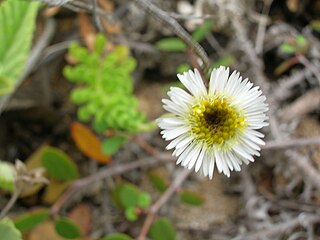
Tetramolopium rockii is a rare species of flowering plant in the family Asteraceae known by the common name dune tetramolopium. It is endemic to Hawaii, where it is known only from the island of Molokai. It is threatened by habitat destruction and degradation caused by deer, cattle, introduced species of plants, and off road vehicles. It is a federally listed threatened of the United States.

Pyrrocoma clementis is a species of flowering plant in the family Asteraceae known by the common name tranquil goldenweed. It is native to Colorado, Utah, and Wyoming in the United States.

Holodiscus dumosus is a species of flowering plant in the rose family, with the common names mountain spray, rock-spiraea, bush oceanspray, and glandular oceanspray.

Neoparrya is a monotypic genus of flowering plant in the carrot family Apiaceae. Its only species is Neoparrya lithophila, also known by the common names Bill's neoparrya and rock-loving aletes. It is native to Colorado and New Mexico.
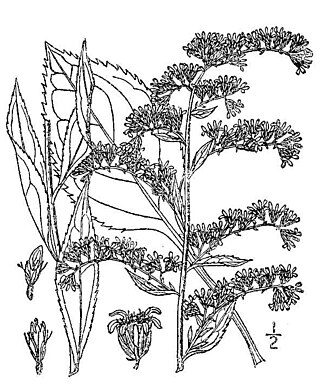
Solidago arguta, commonly called Atlantic goldenrod, cut-leaf goldenrod, and sharp-leaved goldenrod, is a species of flowering plant native to eastern and central North America. It grows along the Gulf and Atlantic states of the United States from Texas to Maine, inland as far as Ontario, Illinois, and Kansas. It is primarily found in areas of woodland openings, such as outcrops or clearings.

Acanthoscyphus is a monotypic genus in the family Polygonaceae that contains the single species Acanthoscyphus parishii, which is sometimes called Parish's oxytheca. This species is native and endemic to southern California.


















